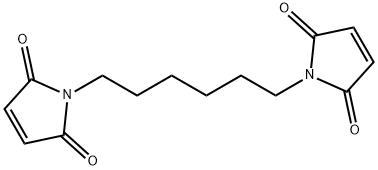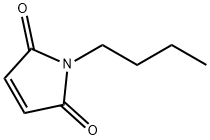1,6-BISMALEIMIDOHEXANE
- CAS NO.:4856-87-5
- Empirical Formula: C14H16N2O4
- Molecular Weight: 276.29
- MDL number: MFCD00047122
- EINECS: 225-449-1
- SAFETY DATA SHEET (SDS)
- Update Date: 2025-01-27 09:32:52

What is 1,6-BISMALEIMIDOHEXANE?
Chemical properties
Off-White Solid
The Uses of 1,6-BISMALEIMIDOHEXANE
A sulfhydryl reactive homobifunctional crosslinking reagent. Under mild conditions, will permit irreversible cross-linking of sulfhydral containing compounds at a pH range of 6.5 to 7.5. Spacer Arm: 16.1 Angstroms
The Uses of 1,6-BISMALEIMIDOHEXANE
A sulfhydryl reactive homobifunctional cross linking reagent. Under mild conditions, will permit irreversible cross-linking of sulfhydral containing compounds at a pH range of 6.5 to 7.5.
What are the applications of Application
1,6-Bis-maleimidohexane is a sulfhydryl reactive maleimide based crosslinker, 16.1 angstrom spacer arm
Properties of 1,6-BISMALEIMIDOHEXANE
| Melting point: | 144 °C |
| Boiling point: | 419.2°C (rough estimate) |
| Density | 1.1933 (rough estimate) |
| refractive index | 1.5500 (estimate) |
| storage temp. | 0-6°C |
| solubility | Soluble in chloroform. |
| pka | -1.90±0.20(Predicted) |
| form | powder to crystal |
| color | White to Almost white |
| InChI | InChI=1S/C14H16N2O4/c17-11-5-6-12(18)15(11)9-3-1-2-4-10-16-13(19)7-8-14(16)20/h5-8H,1-4,9-10H2 |
| CAS DataBase Reference | 4856-87-5(CAS DataBase Reference) |
| EPA Substance Registry System | 1H-Pyrrole-2,5-dione, 1,1'-(1,6-hexanediyl)bis- (4856-87-5) |
Safety information for 1,6-BISMALEIMIDOHEXANE
| Signal word | Warning |
| Pictogram(s) |
 Exclamation Mark Irritant GHS07 |
| GHS Hazard Statements |
H302:Acute toxicity,oral H315:Skin corrosion/irritation H319:Serious eye damage/eye irritation H335:Specific target organ toxicity, single exposure;Respiratory tract irritation |
| Precautionary Statement Codes |
P261:Avoid breathing dust/fume/gas/mist/vapours/spray. P264:Wash hands thoroughly after handling. P264:Wash skin thouroughly after handling. P270:Do not eat, drink or smoke when using this product. P280:Wear protective gloves/protective clothing/eye protection/face protection. P304+P340:IF INHALED: Remove victim to fresh air and Keep at rest in a position comfortable for breathing. P305+P351+P338:IF IN EYES: Rinse cautiously with water for several minutes. Remove contact lenses, if present and easy to do. Continuerinsing. P405:Store locked up. P501:Dispose of contents/container to..… |
Computed Descriptors for 1,6-BISMALEIMIDOHEXANE
| InChIKey | PYVHLZLQVWXBDZ-UHFFFAOYSA-N |
| SMILES | C(N1C(=O)C=CC1=O)CCCCCN1C(=O)C=CC1=O |
New Products
4,4-Difluoropiperidine hydrochloride tert-butyl 9-methoxy-3-azaspiro[5.5]undecane-3-carboxylate Indole Methyl Resin N-Isopropylurea N,N-Dicyclohexylcarbodiimide(DCC) MELDRUMS ACID 5-METHYLISOXAZOLE-4-CARBOXYLIC ACID Magnessium Bis glycinate Zinc ascorbate 1-bromo-2-butyne 2-acetamidophenol 9(10H)-anthracenone Erythrosin B, 4-Piperidinopiperidine 2-((4-morpholinophenylamino) (methylthio) methylene) malononitrile 2,4-dihydroxybenzaldehyde 3-(4-morpholinophenylamino)-5-amino-1H-pyrazole-4-carbonitrile Methyl 2-methylquinoline-6-carboxylate 2,6-dichloro-4-nitropyridine 4-Bromo-2-chlorobenzonitrile 2-(benzylamino)acetic acid hydrochloride 4-(tert-Butoxycarbonylamino)but- 2-ynoic acid 3,4-dihydro-2H-benzo[b][1,4]dioxepine 1-Phenyl-1-cycloprppanecarboxylicacidRelated products of tetrahydrofuran








You may like
-
 1,6-Bis(maleimido)hexane CAS 4856-87-5View Details
1,6-Bis(maleimido)hexane CAS 4856-87-5View Details
4856-87-5 -
 1,1''-(HEXANE-1,6-DIYL)BIS(1H-PYRROLE-2,5-DIONE) CAS 4856-87-5View Details
1,1''-(HEXANE-1,6-DIYL)BIS(1H-PYRROLE-2,5-DIONE) CAS 4856-87-5View Details
4856-87-5 -
 1,6-BMH crosslinker CAS 4856-87-5View Details
1,6-BMH crosslinker CAS 4856-87-5View Details
4856-87-5 -
 3-(4-amino-1-oxoisoindolin-2-yl)-1-methylpiperidine-2,6-dione 98%View Details
3-(4-amino-1-oxoisoindolin-2-yl)-1-methylpiperidine-2,6-dione 98%View Details -
 20677-73-0 (2,2-diethoxyethyl)methylamine 98%View Details
20677-73-0 (2,2-diethoxyethyl)methylamine 98%View Details
20677-73-0 -
 3-(4-(hydroxyamino)-1-oxoisoindolin-2-yl)piperidine-2,6-dione 98%View Details
3-(4-(hydroxyamino)-1-oxoisoindolin-2-yl)piperidine-2,6-dione 98%View Details -
 57381-49-4 2-bromo-4-chlorobenzonitrile 98%View Details
57381-49-4 2-bromo-4-chlorobenzonitrile 98%View Details
57381-49-4 -
 4,6-dichloropyrimidine-5-carbaldehyde 98%View Details
4,6-dichloropyrimidine-5-carbaldehyde 98%View Details
5305-40-8
Statement: All products displayed on this website are only used for non medical purposes such as industrial applications or scientific research, and cannot be used for clinical diagnosis or treatment of humans or animals. They are not medicinal or edible.
